- Author Arianna Cook [email protected].
- Public 2024-01-12 17:55.
- Last modified 2025-06-01 07:38.
Characteristics of the thyme plant, recommendations for planting and caring for a personal plot, advice on reproduction, methods of pest and disease control, interesting notes and applications, types and varieties.
Thyme (Thymus) can be found in some sources under the name Thyme or Thyme. The plant belongs to the Lamiaceae family. The genus in the family is considered the most complex because of its diversity, that is, taxonomic differences. Botanists, in the process of defining a new classification, carried out in 2002, found that the number of species in the genus of thyme reached 214 units. It was decided to split them into eight sections. All plants of this genus grow practically throughout the entire Eurasian territory (excluding zones with a tropical climate); thyme can be found in Greenland and in the northern regions of the African continent. On Russian lands alone, botanists have counted up to 170 species of thyme.
The places where thyme grows are very diverse. These may include forest edges and clearings, steppe and sandy areas, rocky slopes and cliffs, mountain tundra and steppes (with sand and clay soil).
| Family name | Lamiaceae |
| Growing period | Perennial |
| Vegetation form | Shrub or semi-shrub |
| Breeds | Generative (by seeds) and vegetative (by cuttings or dividing the bush) by the method |
| Open ground transplant terms | Mid to late May |
| Landing rules | At a distance of 20-25 cm with a row spacing of 40-50 cm |
| Priming | Nutritious, loose and well-drained |
| Soil acidity values, pH | 6, 5-7 (neutral) and above 7 (alkaline) |
| Illumination level | Well lit or semi-shaded place |
| Humidity level | Moderate watering, more frequent during flowering |
| Special care rules | Fertilizing and pruning is recommended |
| Height options | Up to 0.35 m |
| Flowering period | June August |
| Type of inflorescences or flowers | Capitate or elongated inflorescences |
| Color of flowers | White, pink, violet-red or lilac |
| Fruit type | Box filled with nuts |
| The timing of fruit ripening | Aug. Sept |
| Decorative period | Spring-autumn |
| Application in landscape design | Like a ground cover crop, in a medicinal bed |
| USDA zone | 3-8 |
The plant got its scientific name thanks to the Greek word "thymiama", which meant incense or fragrant smoking. All due to the fact that in Greek temples the cult worshipers of Aphrodite burnt thyme in the temples. In Russian, one can hear such nicknames as Bogorodskaya grass, fly-chop, lemon scent and zhadonik, hog pepper and heather, chebarka and incense.
Plants of the thyme genus are perennial shrubs or semi-shrubs, the height of which does not exceed 0.35 m. Its stems can grow recumbent (creeping) on the surface of the ground or ascending, erect or ascending. Such branches are woody. Flowering stems of a herbaceous type grow ascending. Thyme can also have recumbent, barren branches. The root is also woody and has a rod-like shape. At the base, the stems of thyme gradually lignify over time. They spread over the surface of the soil, are characterized by branching, their surface is covered with hairs that grow both straight and with a bend.
Thyme foliage varies greatly in size and shape. The leaf blade can vary from rounded or ovoid to linear-oblong. The venation on the leaf surface is also very different. The thyme leaves themselves are hard, almost leathery. Usually, leaf plates are attached to the stems by means of short petioles, but in rare cases they grow sessile. Leaves can be whole-edged or sometimes have jagged edges (which are usually characteristic of species that come from the Far Eastern lands).
During flowering, which in thyme occurs in the summer, small flowers open at the ends of the branches, from which capitate or elongated inflorescences are collected. The calyx in the thyme flower is characterized by cylindrical or narrow bell-shaped outlines. Its outer surface is covered with hairs. The lower lip is divided almost to the base into two parts. The contours of the upper lip are wide; it also has up to half a dissection into three lobes. Thyme has a two-lipped corolla. Its color can be white, pink, violet-red or lilac. There are two pairs of stamens, they are erect.
When blooming, a strong, pleasant aroma is heard, indicating the presence of essential oils. This substance helps to protect the plant from direct burning sunlight and summer drought. After pollination occurs, the thyme begins to ripen fruits that take the form of a capsule. They are filled with nuts that have a spherical or ellipsoidal shape. The color of the nuts is black-brown. Fruits ripen throughout August-September.
This representative of the flora does not require special care conditions and today it is grown not only as an ornamental crop, but also as an essential oil plant. It is customary to plant Bogorodsk grass not only on flower beds, but also on beds of medicinal plants, next to lavender and oregano, as well as rosemary, sage and lemon balm.
Recommendations for planting and caring for thyme outdoors

- Landing place thyme is selected well-lit, since the plant is not afraid of the direct rays of the scorching summer sun. But if this is not possible, then a semi-shaded location may also be suitable. In too thick shade, the branches of the incense will begin to stretch strongly and flowering may not come. It is important that the thyme is protected from cold winds and drafts. Also, do not plant in lowlands, where moisture from precipitation or melting snow can accumulate. It is not recommended that groundwater runs nearby. All this will cause waterlogging of the soil and the possibility of fungal diseases.
- Thyme primer should be light and allow water and air to pass well to the taproot. Acidity indicators are preferable neutral with a pH of 6, 5-7 or alkaline - above 7. Too dense soil is recommended to mix with river sand and use drainage when planting. For planting thyme, the soil in the selected area should be prepared in the fall. It is necessary to remove all residues from previous plants and dig up the substrate. It is necessary to add compost or rotted manure to the soil to increase the nutritional value, and potassium-phosphorus preparations are also added there. Before planting thyme in the spring, the garden bed is dug up and loosened again, breaking up large breasts of the soil. Then it is watered with a urea solution (it will act as a nitrogen fertilizer). The solution is mixed at the rate of 1 liter of water, there should be 20 grams of the drug.
- Planting thyme. The best time to transplant seedlings grown indoors is from the third decade of May to early summer. If the soil on the site is heavy, it is recommended to lay a drainage layer (river sand or fine expanded clay) in the hole. Between the holes when planting, the recommended distance is left 20-25 cm, if planting is carried out in rows, then about 40-50 cm is kept between them. After the thyme seedlings are planted, watering and mulching of the substrate surface with pebbles, fine gravel or even medium-sized gravel is carried out. Such a layer will retain moisture in the soil and prevent weeds from growing rapidly.
- Watering when growing thyme, it is recommended to do it in moderation, and only if there is dry and hot weather for a long time. When the flowering process begins, the soil needs to be moistened more often. If in the summer the amount of precipitation is sufficient or too large, then irrigation is not carried out at all.
- Fertilizers when growing thyme, they are introduced only if the soil on the site is very poor. Horny flour is used for feeding. The soil surface where the Bogorodskaya grass is grown should be mulched using rotted compost.
- Pruning when caring for thyme, it should be carried out regularly, as this will contribute to abundant branching. Thyme stems are recommended to be shortened by 2/3 at the beginning of the growing season, the same operation is performed after the flowering process is completed.
- Harvesting thyme performed during the peak flowering period. For this, leafy incense stalks (grass) are suitable. It is not worth pulling out the plant with the root, but you can simply cut it off with scissors. Drying is done outdoors in shade. On clean paper or cloth, the collected material is laid out in a layer of 5-7 cm. It is recommended to turn the grass regularly during the drying process. When the thyme stalks break easily, they are completely dry and threshed. The resulting material must be sieved in order to remove the thick woody parts of the branches. All the herb is folded into paper or linen bags and stored in a dry room with good ventilation for two years.
- Growing thyme indoors. It is noteworthy that thyme can be easily cultivated on the windowsill. For this, a planting pot with a diameter of about 15 cm is selected. Drainage holes are made in its bottom to drain excess moisture. When sowing seeds, a drainage layer, approximately 20-30 cm, must be placed on the bottom of the container. A layer of soil mixture is poured over it so as to completely cover the drainage material. The composition of the substrate can be as previously indicated. The soil in the pot is watered, and then thyme seeds are laid out on its surface. They are sprinkled with a layer of sand of 0.5 cm and sprinkled with warm water from a spray bottle. The pot is covered with glass and placed on a windowsill with good lighting (you can on the south side). But here it is important to provide shading from the direct rays of the sun. The germination rate of the seeds of thyme is excellent, and after a short time you can see thyme sprouts when performing care (watering when the surface of the soil dries up and airing). Then the shelter can be removed. Watering remains moderate and after a month and a half, the first breakthrough of the seedlings can be carried out, removing all weak and frail plants. To obtain fragrant greens, it is recommended to often cut the stems of the Bogorodskaya grass and prevent flowering.
- Growing after thyme. Since the plant can grow on a rather poor soil and does not need abundant feeding and a large amount of microelements, the substrate after thyme does not become depleted. On such beds it is possible to grow any representatives of the flora, the main thing is that they do not belong to the Yasnotkovye family.
- The use of thyme in landscape design. Since thyme has a rather attractive color of flowers, and is also capable of forming spectacular dense ground coverings with its shoots, it is often customary to use it in rockeries, rock gardens or between slabs on paths or in courtyards. Often, these bushes are used in vertical or cascading landscaping. You can plant Bogorodskaya grass plants in garden pots. Due to the fact that the color of flowers in different varieties of thyme is different, then they can form flower arrangements or decorate mixborders. Coniferous representatives of the flora are a good neighborhood for thyme. At the same time, the incense looks organically both with small plants (dwarf pines or low-growing junipers) and large trees (pines, thuja or spruces). Peonies and chrysanthemums can be planted next to their flowering "brothers", lilies, childbirth or tulips look good next to them.
See also outdoor secrets of lavender care and planting.
Thyme breeding tips
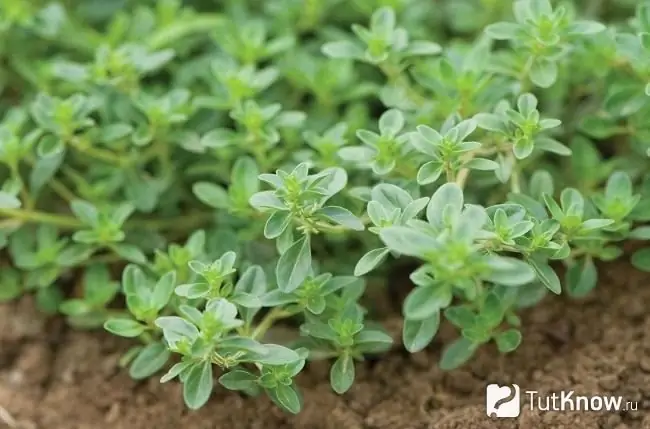
In order to grow bushes of Bogorodskaya grass in the garden, it is recommended to use both the generative method using seed material and the vegetative method, rooting cuttings or dividing an overgrown thyme bush.
Propagation of thyme by seeds
Usually, using seed material, they are engaged in the cultivation of thyme seedlings. The best time for sowing is mid-March. Since the size of the seeds is quite small, in order to facilitate the operation, they are pre-mixed with river sand in a ratio of 1: 3. A substrate intended for growing cacti is poured into the seedling container, and 1/3 of the total volume of chernozem is added to it. Some gardeners use soil for sowing, composed of peat chips and river sand in equal volumes. But such a composition must be disinfected (steamed in the oven or treated with a strong solution of potassium permanganate).
Thyme seeds must be evenly distributed over the surface of the soil mixture. Sprinkle on top of them with a very thin layer of river sand. Then watering is carried out using a finely dispersed spray gun so as not to wash out the sown material. You can put a piece of glass on top of the seedling container or wrap it in a transparent plastic wrap. The rakes are placed in a well-lit place with a heat reading of 20-24 degrees.
Care of thyme seedlings
For at least eight weeks, the sowing and growing of thyme seedlings are taken care of. When young plants of Bogorodskaya grass reach the age of 2, 5 months, they can be planted in open ground on a bed prepared in advance. When sprouts appear, the seedlings need to be moved to a cool room and the shelter removed from the planting container. Care in itself involves watering (using the same spray bottle) when the upper part of the substrate begins to dry out. Where seedlings are kept, good ventilation should be provided, but protection from drafts is important.
Some people sow thyme seeds directly into the open ground when the threat of return frosts recedes. Sowing rules are the same as for seedlings. When leaving, careful watering and weeding is required so that they do not drown out young sprouts of thyme. When growing up, such weeding is recommended to be carried out regularly.
It is noticed that if you carry out an early sowing of thyme seeds or when growing seedlings, then you can enjoy flowering already in the first year from the moment of sowing. If planting was the usual way, then the plants will bloom only after another year.
Propagation of thyme by cuttings
Throughout the growing season, you can engage in rooting of cut branches of Bogorodskaya grass. It is necessary to cut off the green blank from the creeping shoot so that its length is about 10 cm. After that, it is necessary to plant the cuttings in greenhouse conditions for growing or immediately on a flower bed. If the variety of thyme has very low height parameters, then the length of the cuttings should be only 5 cm. After planting, the cuttings of thyme are covered with a glass jar or a plastic bottle with a cut bottom. Rooting care will be moderate soil moisture and periodic ventilation. It is important that the soil is not brought to waterlogging, otherwise it threatens rotting of the cuttings. In a couple of weeks, the seedlings take root.
Propagation of thyme by dividing the bush
When the size of the bush becomes too large, then it can be divided. This process can be done throughout the growing season. With the help of a shovel, a part of the Bogorodskaya grass is separated and transplanted to a prepared place.
Pest and disease control methods for growing thyme
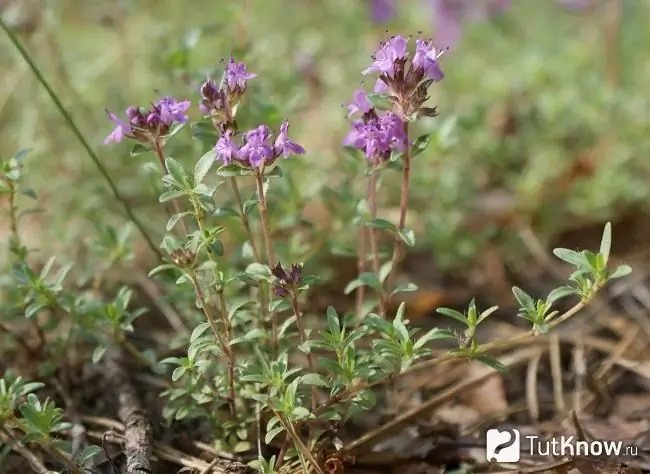
Due to the large amount of highly active substances contained in thyme, as well as essential oils, the plant is rarely attacked by pests and rarely gets sick. However, if the rules of agricultural cultivation are regularly violated, then thyme may suffer from fungal diseases (powdery mildew or various rot). They arise mainly from the flooding of the soil with water and its acidification. If symptoms such as whitish bloom or brown spots on the surface of leaves or stems are noticed, it is necessary to remove all affected parts of the plant and treat with fungicidal preparations such as Horus, Fundazol or Ridomil, others with a similar spectrum of action can be used.
Among the pests that can bring problems when growing thyme are:
- Meadow moths gnawing the entire reverse side of the leaves, after which it remains covered with cobwebs. Damage to flowers and stems also occurs. It is recommended to spray with an insecticide like Decis. For prevention, it is recommended to remove all weeds in the vicinity of thyme plantings.
- Sandy lollipops - black beetles in length not exceeding 0, 7-1 cm. Such pests spoil all aerial parts of thyme. For destruction, it is necessary to use baits poisoned by pesticide preparations.
- Aphids, sucking nutritious cell juices from the stems and leaves of the Bogorodskaya grass, especially when they are very young. All surfaces of the thyme become covered with tiny punctures from pest bites, then yellowing begins and the plant dies. It can also act as a carrier of viral diseases that do not respond to treatment. Insecticides such as Antitlin and Biotlin are used to kill these green bugs and their eggs.
- Weevil, under the influence of which the thyme flowers are injured, since the pest lays larvae in their buds. To combat bugs, it is recommended to use Fitoverm, which will not harm a person.
Read more about pest and disease control when growing mint in the garden.
Interesting notes and uses of thyme
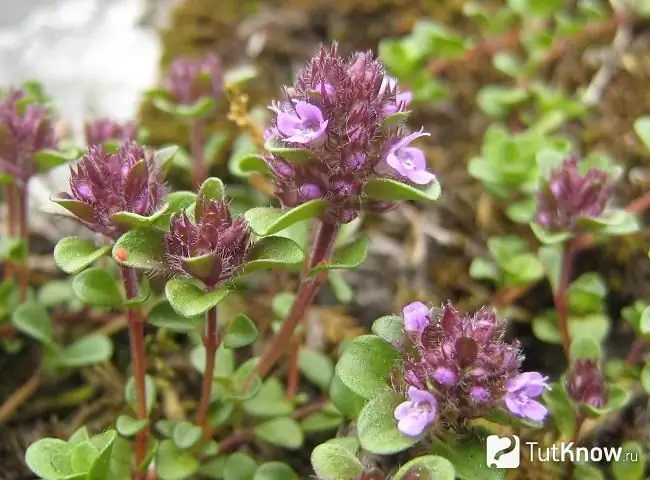
The plant has long been known to people for its many positive properties. The whole part of the thyme growing above the soil surface is considered to be healing. On its basis, folk healers prepared decoctions and tinctures. Such drugs have expectorant and enveloping properties, and are also able to resist microbes. With the help of drugs made from incense, they treated sinusitis and whooping cough, eliminated the manifestations of tracheitis and tonsillitis, they help from sinusitis and bronchopneumonia. This is because medications can help thin phlegm and stimulate the activity of the bronchial glands.
But the medicinal properties of thyme do not end there. For a long time, folk healers used thyme to treat neuralgia and neuroses, eliminated diseases in the gastrointestinal tract, such as atony and intestinal spasms, enterocolitis and dysbiosis, such drugs helped in the fight against flatulence and dyskinesia.
If it was required to conduct an effective fight against pathogenic microflora that did not respond to the use of antibiotics, then thyme-based medicines came to the rescue. When you want your sleep to become strong and calm, insomnia or headache receded, it was recommended to fill the pillow with dried herb of thyme.
All the positive qualities of the plant are given not only by essential oils, of which thyme contains a large amount, but also by gum. There are many tannins and minerals in Bogorodskaya grass, coupled with organic pigments. Speaking purely about essential oils, they are divided into freshly squeezed or, as it is also called, "white thyme" and aged - red thyme. Both have the ability to have a warming effect on the surface of the skin and therefore they are indispensable for medicinal or cosmetic purposes. In any case, when using thyme preparations, you should strictly follow the instructions, but it is better to consult your doctor.
Contraindications for the use of thyme are:
- heart or kidney failure, since thyme contains a large amount of a substance such as thymol;
- a stomach or duodenal ulcer, for the same reason;
- any trimester of pregnancy, since preparations based on Bogorodskaya grass help to contract the uterus;
- exceeding the dosage of thyme-based products or their prolonged use can cause Graves' disease (development of hyperfunction of the thyroid gland);
- children's age (up to 2 years).
Thyme parts are used as Provencal herbs in seasonings and for aroma in the alcoholic beverage industry. Both stems and foliage with flowers can be brewed as tea. The priests of the temples of Aphrodite carried out fumigation with thyme, as it was believed that the plant could give courage, and even in ancient Rome, soldiers were recommended to use baths with decoctions of Bogorodskaya grass. In Scotland, the highlanders regularly drank tea from the aerial part of the plant for the same purpose.
Types and varieties of thyme

Thyme (Thymus vulgaris)
may appear under the names Healing thyme or Medicinal thyme … The area of natural growth falls on the lands of the north-western region of the Mediterranean. The plant with its flowering stems is capable of reaching up to 15 cm in height. The stems are characterized by creeping outlines and cylindrical cross-section. The foliage is petiolate, its shape is lanceolate. The leaves on the back are characterized by pubescence. The length of the leaf plates reaches 1 cm. The color of the leaves is green, but there are species with variegated foliage.
In the middle of summer, the medicinal thyme begins to bloom. At the tops of the stems, capitate inflorescences are formed. The flower petals have a pale lilac hue, almost whitish. Plants with a white, carmine or pinkish tint are often found.
The cultivation of this species in Europe and other countries began in the 16th century, and it is recommended to take care of the plant in the same way as for any ground cover crop.
The common thyme variety has a number of subspecies or varieties that have gained popularity among gardeners. Among them are:
- Alba characterized by snow-white color of flowers;
- Splendens flower petals are cast in carmine red color;
- Elfin is a plant with dwarf dimensions, the height of which does not exceed 5 cm. Through the shoots, cushion thickets are formed, the diameter of which reaches 15 cm.
Recommended for planting plants of this species with different shades of flowers.

Creeping thyme (Thymus serpyllum)
it is he who is called Thyme, on the territory of Russia, the plant has long been called "Bogorodskaya grass". It is a perennial with creeping shoots, characterized by interweaving. The stems have cylindrical leaves. Thanks to the foliage and the strong plexus of branches, the bush is able to form a dense covering, through which the soil is practically indistinguishable. Creeping thyme has a variegated deciduous color and a rich color of petals in flowers. They can take on a white, carmine lily or pink hue. Suitable for lovers of brightly colored garden flora. Flowering stems can be extended to a height of only 15 cm. The species have been cultivated for a very long time.
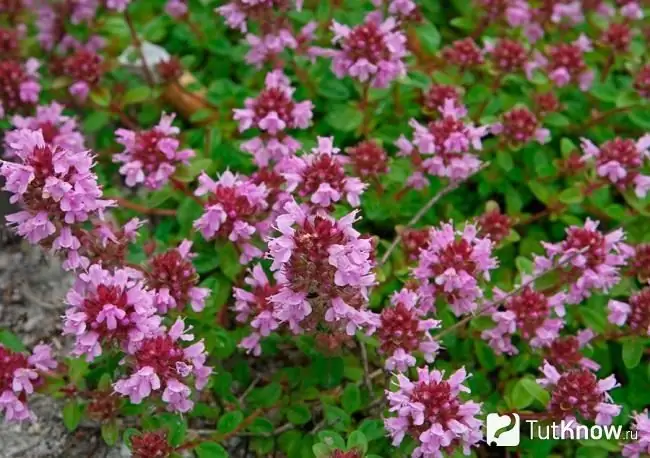
Flea thyme (Thymus pulegioides)
is a shrub with a fairly dense structure. Its size is small, the leaves unfold on the stems, not exceeding 1 cm in length. The foliage is characterized by an elliptical shape. On the tops of the peduncles, from the first summer days, mauve flowers are revealed, gathering in capitate inflorescences.

Lemon thyme (Thymus x citriodorus)
synonymously Thyme is lemon-scented. This species, in accordance with its name, is characterized by a pronounced lemon aroma. Bred by selection, in which the species of common thyme and flea took part. In natural conditions, the plant can be found in the southern regions of France. Peduncles can reach a height of 0.3 m. Flowers in inflorescences are pink in color. The leaf plates have a rounded shape and variegated colors.
The cultivation of this thyme hybrid began at the end of the 16th century (in 1595). When growing in garden, it is recommended to provide such an adult shrub with pruning in due time, which will provide them with decorative effect and stimulate branching to increase density, and for the winter period they will need shelter. The most popular among gardeners are the following varieties:
- Golden Dwarf or Golden gnomecharacterized by foliage adorned with a mottled yellow color scheme;
- Silver Queen or The Silver Queen the owner of leaves, along the edge of which a whitish strip is launched;
- Golden King or Golden Coroeh indicates yellow-edged leaf plates.
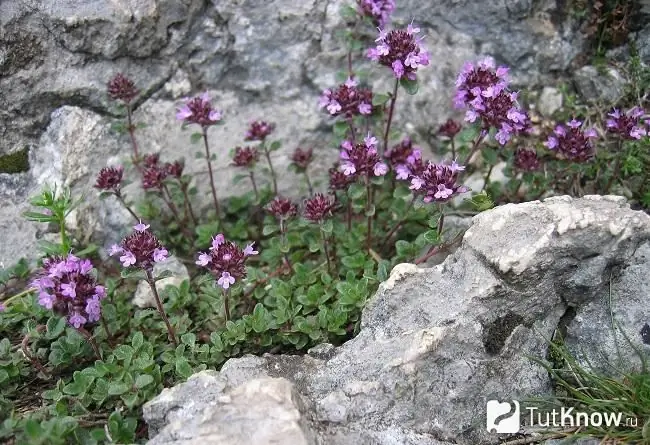
Early thyme (Thymus praecox)
is subdivided into two types:
- Minor with a slow growth rate, but it is recommended for the design of alpine slides, rockeries or small flower beds. Some designers plant such bushes next to water bodies, surrounding stones with such plantings. The leaf plates are pubescent. Their size is small, like the inflorescences. It is thanks to the pubescence and rich light green coloring of the foliage that the plant attracts the eye.
- Pseudolanuginosus (Pseudolanuginosus) is a ground cover of early thyme, capable of forming flower carpets with leafy stems. The number of opened flowers is so great that you can hardly guess the leaves under them. The leaves have a fluffy coating on the surface. The color of the petals in large flowers is lilac.
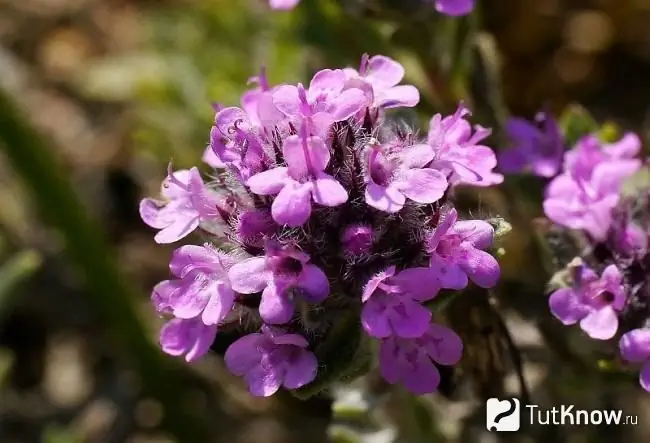
Dorfler's thyme (Thymus doerfleri)
it is rarely grown in gardens, but you can see it in natural conditions on Balki. It is characterized by a low ability to withstand frost, apparently, this influenced its infrequent use, despite its high decorative qualities. The foliage has a pubescence of whitish hairs and curved outlines, which makes them spectacular, as if they were frozen in a gust of wind. Flowering occurs between May and June. The inflorescences are composed of flowers of grayish-pink or pure pink color.
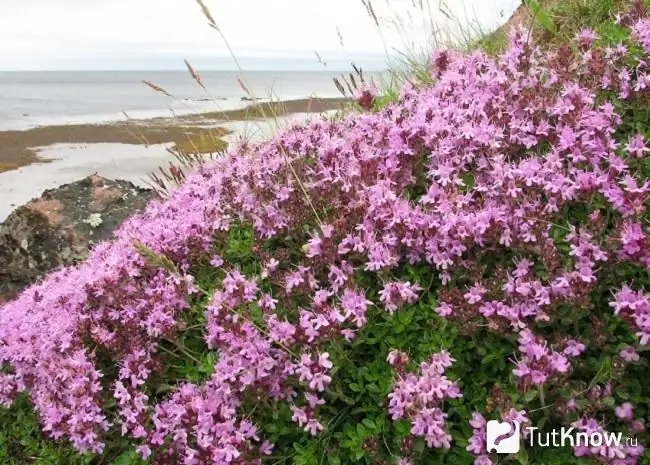
Subarctic thyme (Thymus subarcticus)
resembles from the territory of the eastern and northern European regions. Prefers to settle on rocks, in flattering terrain, along the banks of large and small bodies of water. The plant looks like a semi-shrub, its height is insignificant. The stems can form dense tufts. Shoots grow straight, resembling toy soldiers. Twigs cover dense leaves of small size, the edge of which has a downward bend. The foliage, like the stems, has pubescence.
In the period July-August, their tops of subarctic thyme begin to decorate with loose inflorescences of capitate outlines, composed of bell-shaped flowers. The color of the petals in them is dark purple. When flowering, a pleasant and strong aroma spreads nearby. It is the latter fact that speaks of the high content of essential oils.
Related article: Planting and care rules for growing monarda in the open field
Video about growing thyme on a personal plot:










